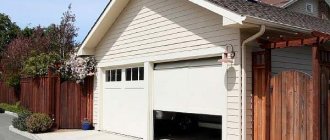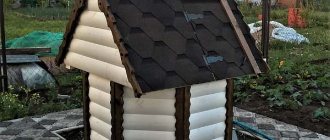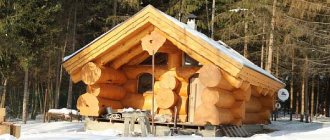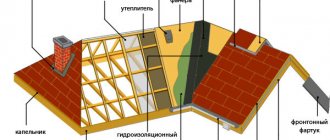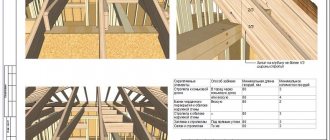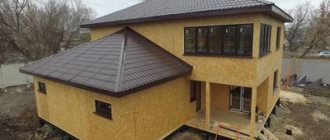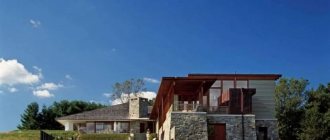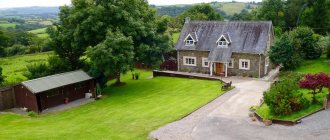- Laws and rules for the location of buildings
- How to take measurements correctly
- Location of the house on the site according to the standards
- Standards for the location of other buildings
- Other requirements and standards for site planning
- Penalties for non-compliance
Before starting active development, each owner needs to study the rules for the location of buildings on a land plot.
This will allow you to subsequently avoid conflicts with neighbors and all kinds of penalties from authorized bodies. Today we will talk about how to properly place structures.
Laws and rules for the location of buildings
To avoid unnecessary questions, we note that the current standards were created taking into account the experience of operating structures and were developed specifically to ensure the safety of health and life. That is, you need to follow the norms not because someone just invented them, this is a real necessity that can save you a lot of nerves, strength and health.
All standards for the location of the house and other structures on the site, which we will talk about, are mandatory or advisory in nature. The first ones must be fulfilled, the second ones - at the request of the owner. The latter include, for example, requirements that were previously in force but were cancelled.
Brief essence
- Beautiful lighting is an integral part of a modern interior.
- When starting to carry out lighting, it is important to take into account many nuances - the area of the room, the type of lamps and their number, the design and purpose of the room.
- There are many layouts of lamps on a suspended ceiling, depending on the area and purpose of the room.
- Each room can be emphasized with skillful lighting. In the living room it is better to combine a chandelier and spotlights, in the bedroom you can get by with only spotlights and sconces, in the nursery it is good to combine a chandelier, sconces and spotlights. In short, any room can be decorated in an original way with the help of beautiful lighting.
Sources
- https://mirdizajna.ru/svetilniki-na-natyazhnoi-potolok/
- https://www.tk-lanskoy.ru/stati/osveshchenie-novinki-i-tendentsii/kak-luchshe-raspolozhit-tochechnye-svetilniki-na-natyazhnom-potolke/
- https://svetosmotr.ru/shema-raspolozheniya-tochechnyh-svetilnikov-na-potolke/
- https://dizajn-gostinoj.com/pol-potolok-steny/raspolozhenie-svetilnikov-na-natyazhnom-potolke.html
- https://DomZastroika.ru/interior/pravilnoe-raspolozhenie-svetilnikov-na-natyazhnom-potolke.html
- https://odinelectric.ru/osveshhenie/kak-pravilno-raspolozhit-tochechnye-svetilniki-na-natjazhnom-potolke
- https://potolokjournal.ru/osveshenie/raspolozhenie-svetilnikov-na-natyazhnom-potolke-11-foto.html
[collapse]
Location of the house on the site according to the standards
The rules for the location of a residential building on a site are regulated by several documents, namely:
- SP 42.13330.2016;
- SP 53.13330.2011;
- SP 30-102-99;
- PZZ of local government.
In accordance with these documents, the house must be located in accordance with the following requirements:
- at least 3 meters from the neighbors’ fence;
- at least 5 meters from the red line of the street;
- at least 3 meters from the red line of passages.
The roof of the building must be built in such a way as to completely prevent water from draining or snow falling onto the territory of neighbors.
When placing a building, it is also necessary to comply with existing fire safety distances.
Choosing lighting for a stretch ceiling
When starting to design, it is important to determine the current lamp. With proper organization of lighting, the comfort of the room will increase. You need to choose based on the decorative parameters of the room and the amount of natural light.
There are 3 types of chandeliers on the market, which differ in the type of attachment to the ceiling:
- Hanging;
- Built-in;
- Ceiling-mounted.
Suspended ones are attached directly to the ceiling using a hook and a strip. The fixation is reliable, durable, fastening elements are not visible. The disadvantage of the system is that the chandelier is mounted to the bar with screws on top of the canvas. This leads to two disadvantages:
- The fabric may tear due to tension and uneven openings;
- Using incandescent or halogen lamps may cause the plastic to melt.
Hanging chandeliers are rarely used in residential premises, but are popular in cafes, restaurants, and bars. They give a large amount of light and cover huge areas.
Embedded systems are almost invisible, as they merge with the panel. A base is mounted on the ceiling in advance. After installing the ceiling, a hole is made in the fabric. A lamp with special springs is inserted into it. They straighten and tightly fix the body. Additionally, a decorative overlay is placed on top.
Visually, the light source completely merges with the surface. It looks laconic, no screws are used. Suitable for residential buildings, they allow you to zone a room. Spots are mounted in a group so that the light flux is larger. Often equipped with a fluorescent flux regulator.
The invoices got their name due to the specifics of the fastening. They are literally superimposed on the fabric. The type of fastening is similar to the previous type. They do not spoil the design of the room.
They can have a rotating (it is possible to manually adjust the direction of the light) and a non-rotating design.
Types of luminous elements for suspended ceilings
There is a large selection of light bulbs on the market. By choosing a device responsibly, you will ensure fire safety and comfortable use of the room.
Spotlights
Spotlights are common for suspended ceilings. They are placed in any order at your discretion.
Spotlights for suspended ceilings are produced with different bases. A small translucent shade is installed on top of the lamp, acting as a light diffuser.
The placement of spotlights on a suspended ceiling can be arbitrary, depending on your requirements. In addition to the standard installation - in a row, it is possible to create compositions, drawings and shapes on the ceiling. Suitable for multi-level structures, they allow you to zone a room. Suitable for any room. Often used in the kitchen, living room, bedroom and even bathroom. There are models with different beam incidence angles.
Surface-mounted lamps
Installed on top of the ceiling using a special rack. A decorative plug is attached to the top. Designed for intense glow, which is convenient in homes with large areas and high ceilings.
The light bulb does not contact the panel, so strong local heating does not occur.
Recessed lighting
Predominantly used with halogen bulbs and designed for high performance. Since their main lighting element is halogen, powerful local heating occurs.
Installed on a special stand using self-tapping screws. Among the disadvantages are the complexity of installation and the likelihood of damaging the canvas with self-tapping screws.
Hanging chandeliers
A common lighting fixture that is attached with a special hook to a ceiling stand. There may be problems with installation since some of the installation is done before stretching. There is a possibility of accidentally damaging the film.
LED types of lamps
LED lamps for suspended ceilings are widespread due to the high performance of the bulbs and minimal heating.
Universal, can be used both in hanging chandeliers and in point light sources. They feature minimal energy consumption with high performance. Only 15 percent of all energy goes into heat, the rest is converted into soft light.
Standards for the location of other buildings
The standards regulate not only the location of residential properties, but also the placement of buildings for other purposes on the site.
Bath
This is a building for economic purposes, the placement of which has the following requirements:
- at least 5 meters to the red line of the road;
- at least 1 meter from the neighbors’ territory;
- at least 6 meters from the windows of neighbors’ residential buildings.
The recommended distance from the bathhouse to a residential building on the same site is 8 meters.
Garage
Standards for garage location on the site:
- at least 1 meter from neighbors’ territory;
- at least 6 meters from the windows of neighbors’ residential buildings;
- compliance with fire safety requirements.
Upon receipt of approval, an exit from the garage can be created at the border of the site.
Well
In accordance with current regulations, the well must be located on the site so that it:
- stood no less than 4 meters from the neighbors’ fence;
- located away from large trees;
- was located no less than 15 meters from outbuildings;
- was at least 30 meters from the septic tank;
- was located no closer than 300 meters to major railways and highways.
Other buildings
Almost any structures placed on the site must comply with current regulations. Let's look at the most common cases:
Boiler room
Since the boiler room is an object of increased fire danger, its placement on the site, including its location to other structures, must be coordinated with the responsible services.
In this case, a fire extinguisher, sand and other essential tools necessary to fight fires should be located nearby.
Greenhouses, chicken coops and other outbuildings
Sheds must be placed on the site in accordance with the following standards:
- the distance to the fence is at least 1 meter;
- the distance to residential buildings is at least 3 meters.
Facilities for keeping animals are located at a distance from cellars and composting facilities - no closer than 4 meters.
The only exception is the dog house. It can be placed at a distance of 1 meter from any structure.
Distances from boundary
In accordance with the current standards for the location of objects on the individual housing construction site, the distance from the boundary to the objects should be:
- 3 meters - for residential buildings;
- 4 meters - for sheds and animal housing facilities;
- 1 meter - for a garage;
- 2.5 meters - for baths and toilets;
- 4 meters - for large trees;
- 2 meters - for medium trees;
- 1 meter - for bushes.
Technical features
The location of lighting fixtures on the tension fabric is calculated at the measurement stage. The coating itself requires preliminary cutting, which takes into account all possible holes:
- for pipes;
- for smoke extractors;
- for ventilation;
- for CCTV cameras;
- for hooks for various suspensions (for example, wicker hanging swings)
- for hanging chandeliers;
- for spotlights.
An already stretched fabric cannot be cut independently, so it is necessary to clearly understand when ordering what will be located and where. As a rule, installation companies know how to correctly position lamps on a suspended ceiling. At the same time, the customer is often offered template options from the catalog of completed work, but they far from exhaust the possibilities of lighting design.
Dimensions and shape
Spotlights are ideal as additional lighting in large rooms. These include:
- living room
- children's room
- bedroom
- kitchen
And as the main source of lighting, they are suitable for small spaces:
- bathroom
- corridor
Why is this so? Firstly, any spotlight has a certain size of the internal part, which is hidden in a niche.
Because of this, it is necessary to reduce the overall ceiling height in the room. The size of the niche will depend on the type of spot.
Therefore, when purchasing in a store, pay attention not only to how they shine or the design of the lampshade itself, but also to the overall dimensions. Otherwise, you will be unpleasantly surprised by the reduction in the size of your room.
For example:
- for lamps with incandescent lamps the ceiling will drop by as much as 12cm
- with halogen lamps – from 4 to 8 cm
- with LED – 5-6cm
It is considered not a very good solution to lower the ceiling by 12cm in the entire room. In this case, it would be correct to choose a chandelier or one large ceiling lamp as the main lighting, which is attached to the zero level.
And make point ones as additional ones. At the same time, lowering the ceiling for them, only in the necessary areas of the room.
In bathrooms, the suspended ceiling is installed around the entire perimeter and is initially lowered to a certain height. As a result, the same niche is formed, ideal for built-in spots.
However, if your bathroom is of royal size, then it makes sense to do the same here as in large rooms. That is, the main point of lighting in the center, plus additional ones around the perimeter.
Also, recessed lights are ideal for small and oblong corridors. They can be easily distributed over the entire area, thereby achieving uniform illumination.
In fact, the corridor is a passage area. And the low ceiling here will not particularly attract attention.
One of the important mistakes that can ruin the entire design is the color of the housings of spotlights.
The simplest and most suitable for any style of room would be a white spot.
Exactly white, since this lamp will turn into part of the ceiling and will be completely invisible.
Unlike spot models in gold, silver or bronze.
Here the difference can be seen with the naked eye.
Distances between lamps and indentations
Here are the main distances that should be followed when choosing the location of spotlights in a suspended ceiling:
- from the edge of the wall to the first lamp you need to maintain a minimum distance of 20cm
- The minimum distance between built-in ceiling lights is 30cm
- if the ceiling consists of several welded sheets, then the lamp housings should be located 15 cm from the seam
Location recommendations
In large rooms with a central chandelier, lamps should be installed in the corners and least lit areas of the ceiling.
Cross lighting in a narrow room will visually expand it.
And when using 20 or more light points, it is recommended to group them into zones with separate, independent power supply.
When installing a chandelier, it is placed in the center as usual. The entire further composition is built around this point. In this case it can be:
- symmetrical
- asymmetrical
However, regardless of this, the chandelier is always the starting point for the whole picture.
Other requirements and standards for site planning
In addition, when determining the permitted location of buildings on a site in 2021, existing sanitary, fire and environmental standards must be taken into account.
Sanitary
These are standards designed to protect the health and lives of people, so they cannot be neglected. In accordance with them it is necessary:
- keep the house and cellar 12 meters away from animal sheds and outdoor toilets;
- ensure a distance of 8 meters or more between the house/cellar and the bathhouse;
- maintain at least 8 meters between the well on one side and the septic tank, toilet or compost heap on the other.
The same standards apply to residential buildings in neighboring areas.
Fire protection
According to the current requirements in Russia, the distance between buildings within the site must correspond to the following table:
You need to work with the table as follows: let’s say you need to calculate the distance between your concrete house and your neighbor’s wooden one. You need to find the intersection between A (non-combustible building) and B (combustible) - 10 meters.
Environmental
Their main purpose is to preserve nature. According to them:
- the building boundary must begin at a distance of at least 15 meters from the forest boundaries;
- It is prohibited to fence off areas for the beach or walkways on the coastline.
Conditions for the construction of a second residential building on a land plot
It is very important to maintain the correct distances when building a second household on the site. There is no direct prohibition on the construction of such an object by law, however, when legalizing the structure, problems may arise due to violation of the minimum gaps.
The standards for the construction of a second home are related to the maximum permitted percentage of development , as well as the smallest gaps between the house and the boundary of the land plot. These data are determined by the city municipality, so these indicators may differ significantly for each locality.
In order to find these readings, you need to go to the website Rules for land use and development of a specific area, for example, the Moscow region. The archive contains a Town Planning Plan or Zoning Map, the Rules indicate the maximum percentage of development of 40% and the setback from each household to the boundaries of the land plot is 3 m.
For land of 6 acres, two houses (without other buildings) should have an area of no more than: 600X0.4:2 = 120 m2 , and the distance between them should be 6 m. If additional utility facilities are built, the area of the houses should be reduced accordingly.
Penalties for non-compliance
Current legislation provides for penalties for owners who do not comply with these norms and requirements. If they are ignored, penalties may be applied to the person:
- administrative responsibility;
- fines;
- mandatory demolition of structures that do not meet the standards.
Compliance with the rules is not just an obligation, it is an opportunity to develop a site comfortably and safely. Regulations are created to protect people from many problems. By ignoring the rules, you endanger yourself and your loved ones.
The Render House company is engaged in the construction of turnkey cottages in compliance with all norms and requirements. To get advice and choose a project, call the phone number in the site header.
What should the fence be like?
SNiP imposes some requirements on the fences themselves. For the most part, they are advisory in nature, and it is not at all difficult to comply with them.
The fence between land plots should not exceed 1.5 m in height . Moreover, it can only be continuous up to the middle. Otherwise, a neighbor may complain about excessive shading of the area.
The choice of fence material remains with the owner of the site; the regulatory documents do not contain any recommendations regarding this. This could be a chain-link mesh, trellises or even a picket fence.
The height of the external fence is not regulated. However, if this figure exceeds 2m, additional approval may be required. The external fence can be solid, for example, made of corrugated sheets.
If you can come to an agreement with your neighbors, you can put up any fence, even a solid fence 3m high. The most important thing is to draw up a document confirming the agreement with the owner of the adjacent plot.
